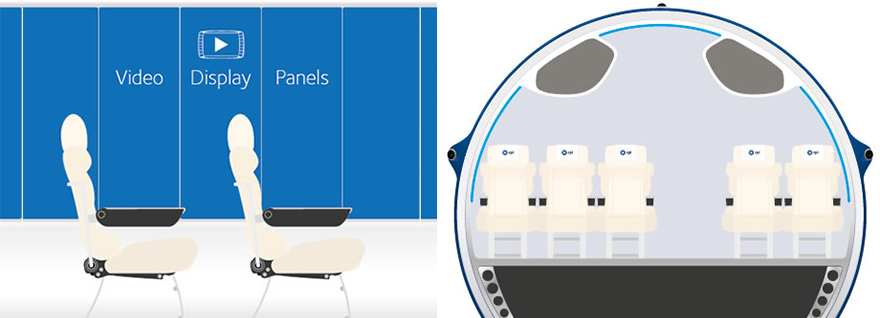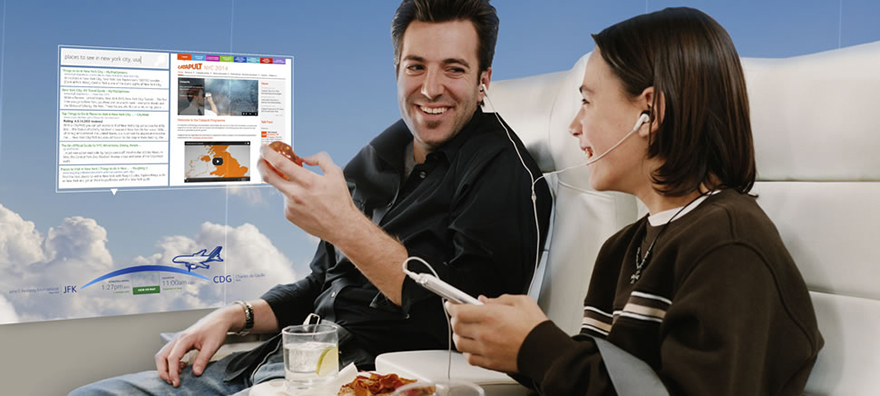Are Windowless Planes the Future of Flying?

Are you one of those who suffer from aerophobia – fear of flying? Then you won’t be too thrilled to read about the new breakthrough in the aerospace industry.Otherwise, you will probably be intrigued by the new windowless planes, planned to set off in a decade. The term “windowless planes” may not be the most elegant one as it inspires claustrophobia in many. However, these planes would be everything but claustrophobic – designed to enhance the joy of travel and cater to the passengers’ need for visual stimulation.
In a decade or so, commercial flights may look a lot different than those in the present. Mini-windows on planes could easily become obsolete and they could be replaced by gigantic OLED screens. The planes of the future, as imagined by The Center for Process Innovation, will be entirely windowless, but giving all passengers an equal chance to enjoy the panorama. No more window seats – that will become a thing of the past.
The Center for Process Innovation (CPI) is a British technology research company working on transforming this idea into reality. They have unveiled their new, futuristic design of the Windowless Fuselage that could become feasible in a decade, according to their estimation. You can watch their video and see the basic concept of the new technology.
Who are the CPI? This company is one of the members of the UK’s High Value Manufacturing Catapult network. The goal of this network is to transform emerging industry innovations and ideas and into tangible products. They have access to the best development facilities in the country and work with other companies on rapid commercialization and full-scale production.
The vision of the CPI is replacing all windows in the plane with full length OLED touch-screens that would display the world around the airplane. These screens would be connected to cameras positioned on the plane’s exterior. This way, a display will be a real “window” into the world for the pilots and a great source of entertainment for the passengers.
According to CPI, the displays will be touch-screens, providing important information to passengers and allowing them to choose their flight attendant and entertainments service (movies, commercials…) Passengers will be able to turn them off if they wish. Also, the screens will be able to display other points of interests in real time, such as the International Space Station and other airplanes.
What are, in fact, OLEDs? The characteristic of material from which they are made is that it is able to give out its own light when turned on by electricity (1). This advanced material (organic light-emitting diodes) is used to make lighting and screens, and now – it will be used to modernize passenger airplanes. Compared to standard LCD and plasma displays, OLEDs don’t need a backlight, they use less energy and they are much thinner and flexible.

One of the researchers’ ambitions is printing OLEDs on sheets of paper and placing them on the wall so they can turn the walls into lights. Also, they revealed specifications for the displays and they are: 150 dpi color resolution, 100 cd/m2 display luminance and 20,000 hours of lifetime (before replacement). CPI believes that this could be easily achieved if the displays are about 50 cm high.

These futuristic planes would have one big advantage over ordinary crafts with windows. The screens should be extremely thin, flexible, lightweight and embedded into fuselage lining panels, so the overall weight of the plane would be significantly reduced. This seems logical if you are aware that windows are one of the heaviest parts in standard passenger planes. The aircraft and its fuel together make up over 80 percent of the weight.
The reduction in weight would bring significant fuel savings and lower operational costs. For every 1 percent of weight reduction, the approximate fuel saving is 0.75 percent. Of course, using less fuel is environmentally friendly as it reduces the emission of pollutants into the air. Therefore, ecologically conscious people can relax – this new technology is designed with the preservation of the environment in mind.
What are the current obstacles in building windowless planes? At the moment, the technology is still too expensive and difficult to produce. The design needs to be modified in such a way that creating OLEDs becomes a little bit cheaper without losing their high quality and durability. Some who criticize this new aircraft design are worried because of the light pollution that OLEDs will produce. They also point out the fact that a panoramic view may be horrifying to those with aerophobia.
Dr Jon Helliwell of the CPI gave his opinion to The Guardian: “We had been speaking to people in aerospace and we understood that there was this need to take weight out of aircraft.” He added: “We are talking about [the idea] now because it matches the kind of development timelines that they have in the aerospace industry.” (2)
He also explains the numerous possibilities for passengers who will be flying in windowless planes: “So you could have a display next to a seat if you wanted it; you could have a blank area next to a seat if you wanted it; you would have complete flexibility as to where you put [the panel screens]. You could put screens on the back of the seats in the middle and link them to the same cameras.”
CPI also claims that displays will increase the sensation of looking out of a window and the passengers won’t have the feeling that they are looking at a projected image. There is also a possibility of projecting the image onto the screen from the passenger’s point of view and the image would move in accordance with the passenger’s head. Passengers would also have a beautiful, uninterrupted view of the exterior without seeing engines and wings. With all these wonderful possibilities and improvements, we cannot but look forward to flying after 2025.
Resources:
- How OLEDs Work, How Stuff Works
- Shane Hickey, The windowless plane set for take-off in a decade, The Guardian, Oct 2014
Images: Bored Panda
Ivanovic J (2014-11-24 13:21:51). Are Windowless Planes the Future of Flying?. Australian Science. Retrieved: Jul 12, 2025, from https://ozscience.com/technology/windowless-planes-future-flying/
 Follow
Follow